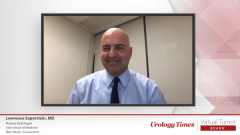
PSMA PET Clinical Trials
Experts review ongoing clinical trials in PSMA PET technology.
Episodes in this series

Neal Shore, MD, FACS: Larry, you touched on the cyclotron and generator issues. I’m curious if you could elaborate more on that? Because going from December 2020 through December 2021 as well as in May, despite COVID-19, a worldwide pandemic, we did make advances. We continue to make advances in some therapeutics, but wonderfully, in imaging and diagnostics. That’s to the credit of many of your efforts and Michael’s efforts and doing these trials that get these PET [positron emission tomography] tracers approved. There’s more to come.
Lawrence Saperstein, MD: Yes, it’s been a very exciting last few years, starting with Gallium PSMA [prostate-specific membrane antigen]-11, then PyL obviously, and more recently, the PSMA-11 kit, which we haven’t seen just yet. But it’s getting exciting in terms of what we can offer our patients. Going back to the cyclotron vs the generator, I think the vendors will iron out those details and they’ll ramp up their facilities to meet the need. It’s just a matter of having a generator that can elute only a certain number of doses of gallium a day vs a cyclotron, which has the longer half-life and can be transported from a larger facility to the sites where they are imaging. These are challenges. There are pros and cons of each scenario depending on the site, but I think we will be poised to meet the demand. I’m hopeful and confident.
Neal Shore, MD, FACS: I just came back the other day from ASCO GU [American Society of Clinical Oncology Genitourinary Cancers Symposium 2022] in San Francisco, and they presented the rhPSMA PET and the SPOTLIGHT trial. That’s another PSMA PET that will potentially get FDA approval sometime in 2022. I know there are other assays that are being looked at for PSMA PET. I’m curious, Michael or Larry or Steven, do you want to comment on any work that you’re doing? We’ve gone from having no PSMA PET and suddenly we may have 3 or 4 available. We’ve gone from 0 to 60 [miles an hour] after lagging behind many other parts of the globe. I’ll start with you Michael, and then Larry or Steven, if you have comments on any ongoing trials of other PSMA PET technologies.
Michael Gorin, MD: Yes, it seems to me that probably the next one in the pipeline for the United States is going to be the rhPSMA-7.3, which is a compound in Blue Earth [Diagnostic]’s pipeline basically to replace Axumin, which they had previously. As you pointed out, the SPOTLIGHT trial reported results at ASCO, essentially meeting all the primary end points of that study. They’re probably likely soon to publish the results of the LIGHTHOUSE trial, which is their companion to it. As I understand things, those 2 studies will be bundled together and submitted for a new drug application to the FDA, and this will probably occur in the next year or so. The rhPSMA molecule is quite interesting because it has the ability in the same molecule to be used both as a therapeutic and a diagnostic agent. And if we have some time later, perhaps we could talk about the chemistry of how that’s achieved. There certainly are other PSMA molecules as well. Quite commonly, if you look in the literature, you’ll see PSMA-1007, which is another fluorinated agent that is being heavily used in Europe. This agent offers some benefits in terms of where the uptake is, how it’s excreted, and so forth, which perhaps offers some advantages over the current agents.
Going back to the discussion about why we have lagged so far behind in the United States, a big part of it has to do with the fact that we have to go through the FDA when we want one of these compounds. We require things like the OSPREY and the CONDOR trials, and SPOTLIGHT and LIGHTHOUSE, and whatnot. Whereas in Australia and Germany, where much of the PSMA work started, they have different laws that allow that if a radiotherapeutic agent could be compounded in the radiopharmacy at the hospital, they don’t require any regulatory approval at all. They can simply administer these agents to patients. If the new kid on the block comes out with superior properties, as long as they can synthesize it at their center, they start using it right away. We’re already 5 years behind the ball in the United States because we have to have a commercial entity that gets behind it and puts forth these trials, and goes to the FDA, and so forth. We’re always going to be playing catch up I believe in this space.
Neal Shore, MD, FACS: That’s a great summary. Any other thoughts, Larry or Steven? Any additional assays that you’re working with, or thoughts on comments that Michael just gave? It was a great overview.
Steven Finkelstein, MD, DABR, FACRO: Yes, that was a wonderful overview. I would say that there is a focus, there are behind-the-scenes people working toward the theragnostic aspect of this. Now that there have been a couple of companies who’ve been able to come forth with a diagnostic agent, they see a pathway where if I do a trial that’s very similar and we tie a theragnostic to it, that is a very exciting thing for them. I think that will be very exciting in the clinical trial world, to come within the next 5 years.
Transcript edited for clarity.
Newsletter
Stay current with the latest urology news and practice-changing insights — sign up now for the essential updates every urologist needs.























